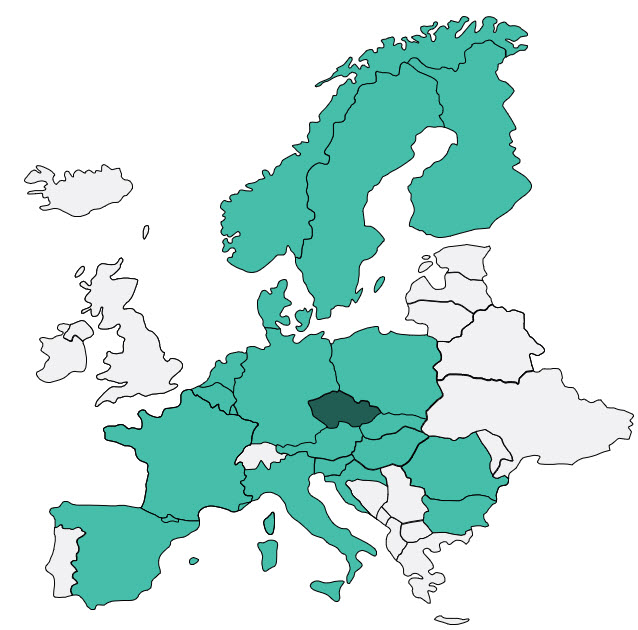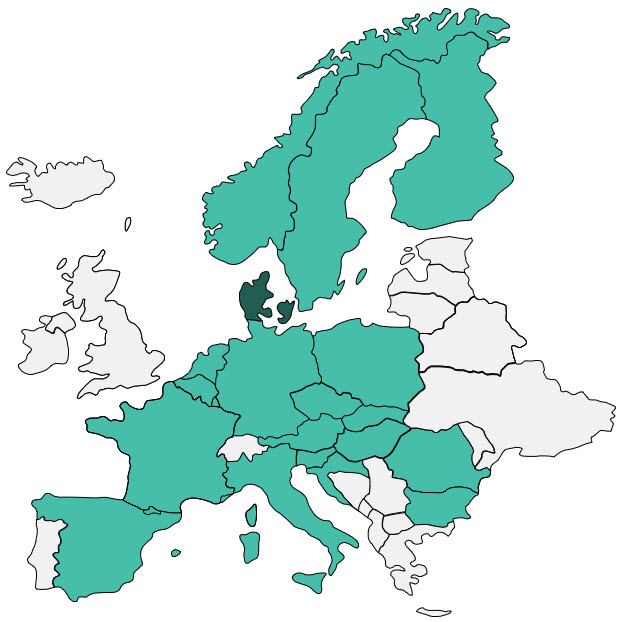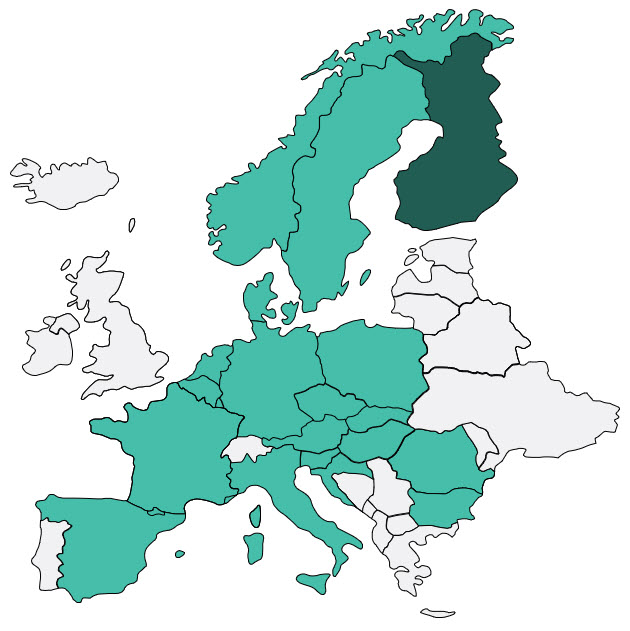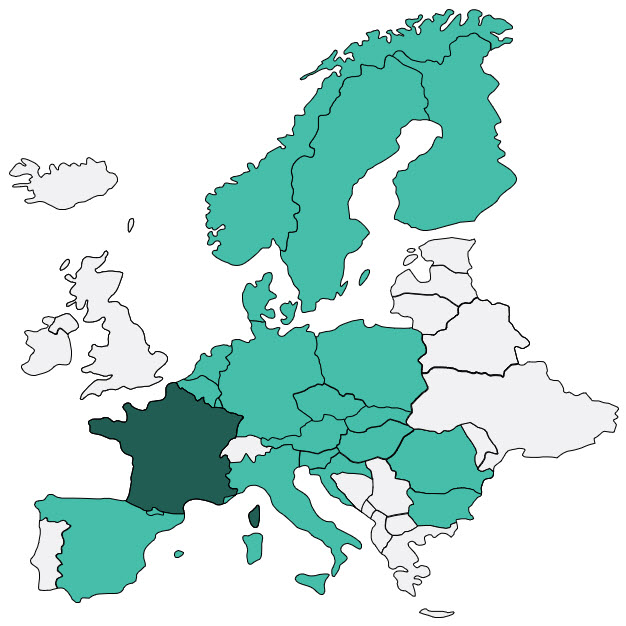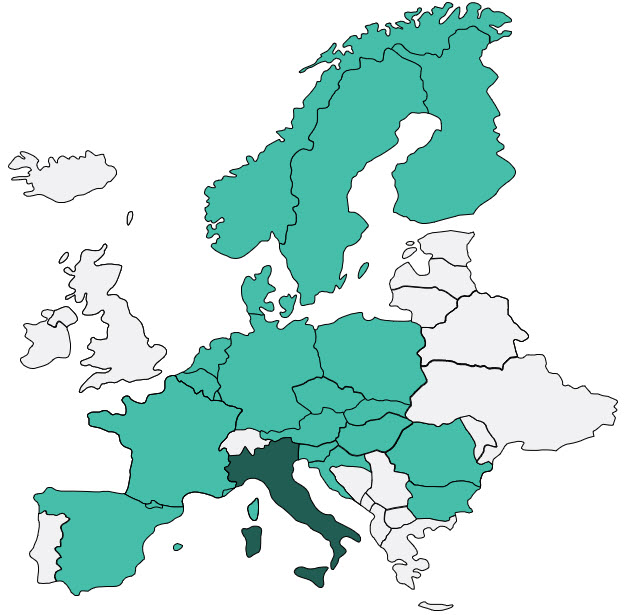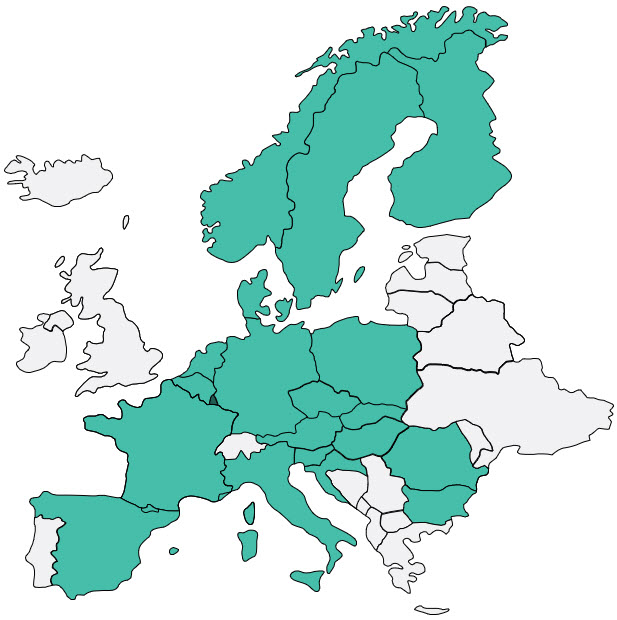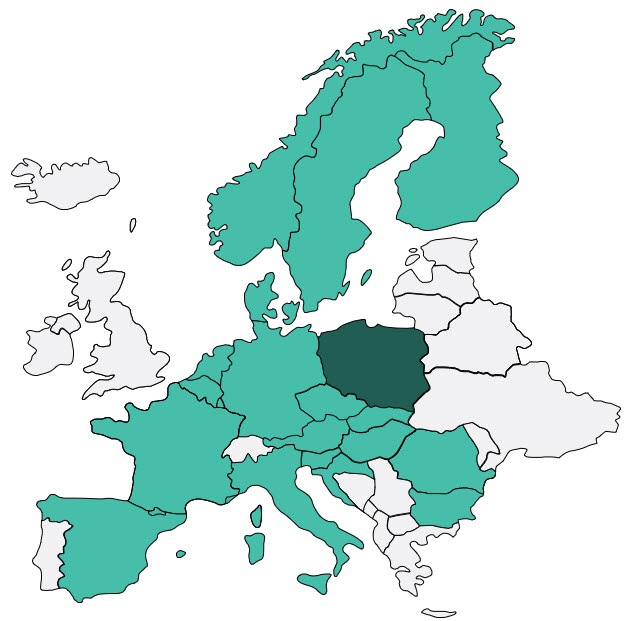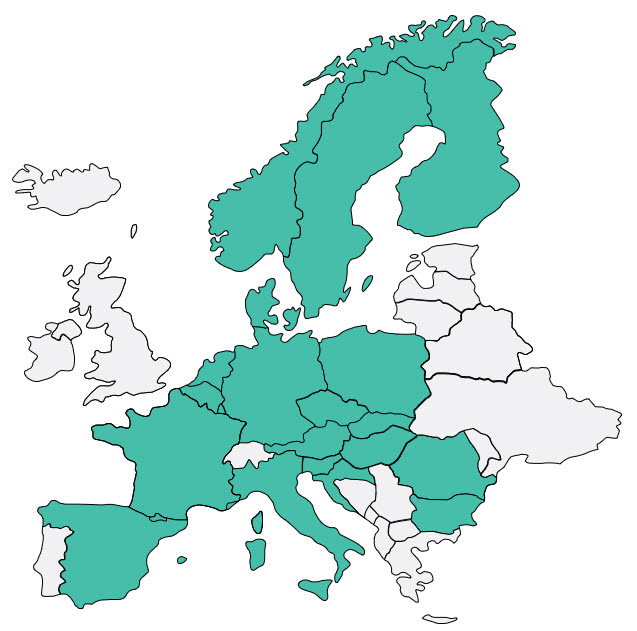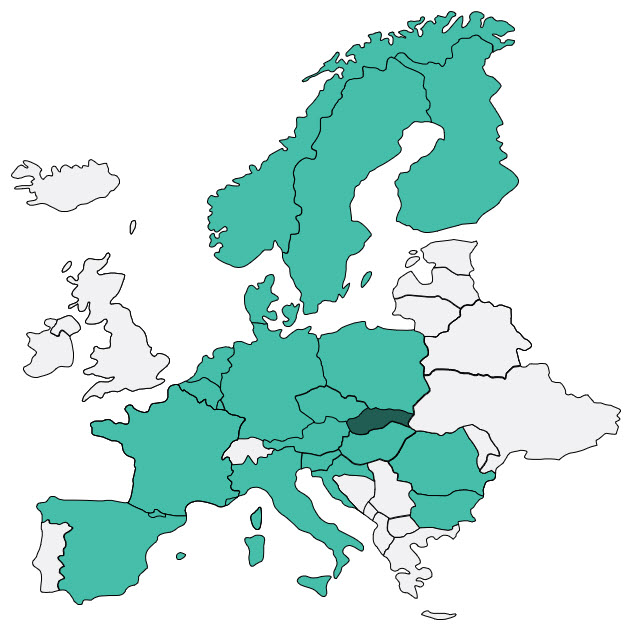Bulgaria
Bulgaria
Here is the list of Bulgarian banks that you can initiate payments or
retrieve data from using our Open Banking products:
- DSK Bank
- Eurobank Bulgaria (Postbank)
- First Investment Bank
- Raiffeisenbank, Bulgaria
- Revolut
- Unicredit Bulbank AD
- United Bulgarian Bank

Belgium
Belgium
Here is the list of Belgian banks that you can initiate payments or
retrieve data from using our Open Banking products:
- Argenta
- AXA Banque (since 2021 Crelan)
- Belfius
- Bpost Bank (since 2024 BNP Paribas)
- BNP Fintro
- BNP Paribas Fortis
- Crelan
- Europabank
- ING Belgium
- KBC
- N26
- Nagelmackers
- Revolut
- VDK

Austria
Austria
Here is the list of Austrian banks that you can initiate payments
or retrieve data from using our Open Banking products:
- Austrian Anadi Bank
- Bank Austria
- Bank Burgenland
- Bank Winter & Co AG
- Bawag PSK
- Capital Bank
- DADAT (Direktbank der GRAWE Gruppe)
- DolomitenBank Osttirol-Westkärnten eG
- Easybank
- Erste Bank
- Generali Bank AG
- Hello Bank Austria
- HYPO NOE Gruppe
- Hypo Vorarlberg Bank AG
- ING Diba Bank
- N26
- Oberbank
- Raiffeisen Bank International
- Revolut
- Schelhammer & Schattera
- Schoellerbank AG
- Volksbank Gruppe
- VR-Bank Braunau

Images - test
Supported Countries
Supported Countries
We support payments and account data in 20 countries,
covering at least 80% of payment accounts in each.
We are continually expanding our reach and updating our list.
If you're interested in a specific country or bank not listed,
please reach out to us - we're here to help!
As a registered user, you can jump straight to the country pages and
check out the list of banks from which you can initiate payments or
retrieve data using our Open Banking products.
Not signed up yet? Just register here!
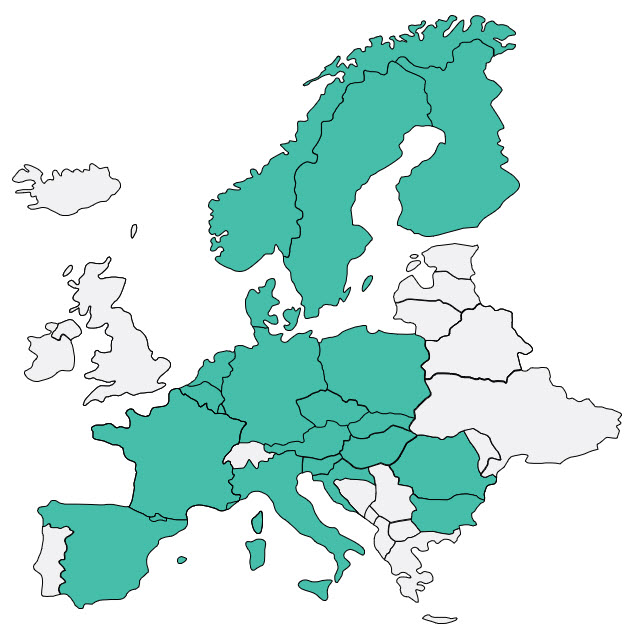
Getting Started with FIDO Server by Worldline
Prerequisites
You need to keep your client_id and secret_id that was sent to you by mail.
If you lost your secret_id, please contact us to generate a new one for you.
There is two types of credentials with different scope. The firsts credentials you received are for the administrative scope, to manage your relying parties servers. You have to use these firsts credentials to create a relying party via API, and in response you will received second credentials related to your relying party with "service" scope that will enable you to configure it and handle your users via API.
These credentials are needed for all interactions with the Fido Server by Worldline.
You also need the audience to access generate bearer tokens.
OAuth2 Server URL : https://access.fido.worldline-solutions.com
Audience : https://my-wafl-api-gateway-6glqflxv.ew.gateway.dev - to update
API access and authentication
The FIDO Server by Worldline (also called WAFL Server) API uses the OAuth Client Credentials Flow to authenticate API calls.
Request tokens
Example using curl
curl --request POST \
--url 'https://access.fido.dev.worldline-solutions.com/oauth2/token' \
--header 'Content-Type: application/x-www-form-urlencoded' \
--header 'Authorization: Basic Base64Encode(concat('client_id', ':', 'client_secret'))' \
--data 'grant_type=client_credentials' \
--data 'audience=https://my-wafl-api-gateway-206w9c7e.ew.gateway.dev'Parameters
- grant_type : set this to your "client_credentials"
- audience : the audiance for the token (see the prerequisites)
Response
If all goes well, you'll receive an HTTP 200 response with a payload containing access_token, and expires_in values:
{
"access_token": "eyJz93a...k4laUWw",
"expires_in": 3600
}Access token lifetime
The lifetime of a token is set to 3600 seconds
Use the Worldline FIDO Server APIs
Declare your relying party server
Once you received your credentials by mail with the "admin" scope, you can declare your relying party server with the admin/relying-parties API, where you give the name of your relying party, and get the credentials with the "service" scope that you can configure in your relying party server to use the FIDO authentication service.
You also have to declare the origins of your relying party application with the admin/relying-parties/{id}/origins API.
Enable your users to register
You can use our Browser SDK to facilitate the integration of FIDO protocol into your web application and use the browser APIs.
The registration is a two steps action as it contains an initiation step to generate the challenge that will be used by the authenticator for cryptographic operations.
In the initiation step your relying party gives information about the registration like the username, friendlyName and authenticator properties. The Worldline FIDO server respond with a challenge to give to the authenticator.
The attestationBlob, response of the authenticator, is passed through the finalization step so that the Fido server complete the registration.
Enable your users to authenticate
The authentication is also a two steps action as it contains an initiation step to generate the challenge that will be used by the authenticator for cryptographic operations.
The initiation step is where your relying party informs the server for which user you want to do an authentication. The response contains the challenge on which the authenticator will have to make cryptographic operations.
The result of these operations is passed through the finalization step in the assertionBlob where the Fido Server will do the authentication.
Manage your users
Once your users are registered, you can list their authenticators, update the friendlyName of an authenticator (for the user to better identify his authenticator) and delete them via the /users APIs.
Transactions
Transactions
Retrieve Transaction Details
The API allows the transaction details to be retrieved.
The main input fields are:
- The issuer ID
- The transaction for which the detail is requested: It is provided by using the transaction Id.
It is also possible to request some additional data relative to addendum (to retrieve lodging information, car rental information, air itinerary information) by using the embedded fields.
In return, the interface provides the generic information (mainly master data) relevant to the transaction.
API links
Search Transactions (Global)
The API provides possibility to retrieve a list of transactions (original first presentments received from the card schemes), based on certain criteria.
To prevent overly broad searches, at least one of the following conditional search criteria must be provided :
- PAN
- PAN token
- Transaction identifier
- Acquirer reference number
- Virtual Service Card Number
- Card Identifier
- Account Identifier
- Related Transaction
If requested, the API allows also to:
- search from an issuer and optionally with sub-issuers OR search from a list of issuers (by default, the search is performed on all issuers allowed for the user depending on its rights)
- return only certain transactions (disputed transactions, fraudulent transactions)
- request to enrich the response with additional data relative to addendum (to retrieve lodging information, car rental information, air itinerary information) by using embedded fields
The API response contains all matched transactions sorted by descending transaction date.
API links
Create a Dispute from a Transaction
The API allows an issuer to create a dispute folder in the system for a given transaction. This API enables the issuer to initiate the dispute from its application.
Several actions can be performed :
- Dispute only
- Dispute + refund/redebit (full or partial)
- Dispute + write-off (full or partial)
- Dispute + fraud declaration
- Dispute + event creation
- Dispute + attach documents
- Dispute + combination of above options
Main data in input are :
- the transaction for which the dispute is requested: It is provided by using the transaction Id. The transaction can be retrieved using the API Search transactions
- in option, several fields in the case additional actions have to be done besides the dispute folder creation (e.g. operation(s) posting, event(s) creation, add document(s)).
In response, the created dispute folder identifier is provided back systematically; then depending on the additional requests, the response includes also the posting, event creation and documents add response.
Idempotency is managed by the API; that is, if the request with the same WL-Correlation-ID is sent multiple times, it will be executed only once. The response will be retrieved directly from our system.
API links
RBA Scoring WS Client
Data Export
Data Export
Current version 25R2-1.0 of September 4th 2025
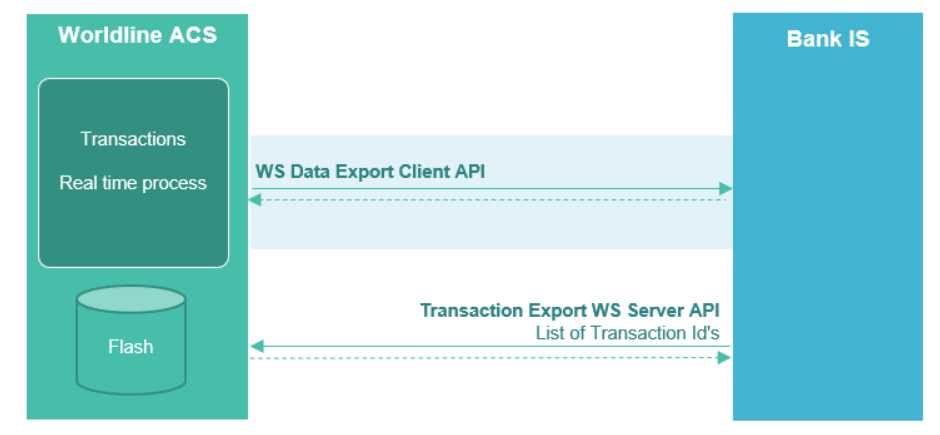
Data export solution description
The data export solution is a new external Push Service totally independent from the existing scoring notification request, containing a maximum of information of the transaction and the authentication process.
The platform HUB purposes two kinds connectivity with banks for this purpose.
- The data are sent by Webservice to API REST bank Server end-point
or
- The data are sent by file to bank file Server
1. Data export scheme
The data export solution defined is based on data conveyed in the AReq and RReq messages + Scoring and authentication process.
It takes advantage of the HUB to provide the necessary available data from those messages.
The HUB is the key module to collect and to treat those data as it is the central module involved in the 3DS authentication process.
The messages contain most of the relevant information needed to get the context of a transaction and to provide enough information to consolidate and refine the authorization process.

Workflow of the process:
- The HUB collect data from Areq and Rreq messages.
- The datas are encrypted and sent through messages to the transaction export gateway.
- The data are sent through a specific gateway to the IS bank.
2. Real-time push option
With this solution, bank will be able to receive the data just after the authentication transaction ending (after RReq/RRes message).
The data are pushed to bank through a dedicated Webservice API.
The data will be sent on a REST JSON format. The Web Services will be transmitted in HTTPS - TLS 1.2 and will be configured on the Worldline PCI-DSS Proxy as followed:
- By default on internet with a mandatory mutualized authentication
- If asked by the bank, on a VPN or LS
A rate limiter is defined (max TPS) on the HUB push platform and must be configured depending on Issuer Bank transaction volume and IS Bank Server capacity.
If the HUB cannot reach the bank Webservice, a retry process is forecasted. This retry flow is ordered by a FIFO rule.
Two kind of errors are defined, some are due to context and triggers a retry attempt, some are due to data or configuration error and will no triggered any retry. Cf. 3.5.1.2
The retention of data is fixed for a 4 days period. During this time laps the transactions are systematically pushed to the bank until the bank module responds.
After 4 days, the transaction and data not transmitted are deleted from the queue.
3. Configuration
3.1. Data encryption
Sensitive data should be encrypted or masked.
We define 3 types of sensitive data :
- GDPR ; information which allows to identify a person
- PCI-DSS ; card information
- PCI-3DS ; 3DS protocol sensitive information
The configuration depends on the level of Certification of the Server platform.
For example ;
if the platform is certified PCI-3DS, authenticationValue can be sent encrypted otherwise it can be only sent hashed or omitted.
if the platform is certified PCI-DSS, pan can be sent encrypted otherwise it can be only sent masked or omitted.
As there is less requirement on GDPR data, data can be sent either in plain text or encrypted.
Table of configuration :
| Security Level | Field(s) | Configurations Available | |||
| NONE | Plain text | Hashed (SHA256) | Encrypted | ||
| GDPR | credentials, shipAddrCity, shipAddrCountry, shipAddrPostCode, billAddrCity, billAddrCountry, billAddrPostCode, email, mobilePhone, homePhone, workPhone | X | X | X | |
| PCI-DSS | PAN, ExpiryDate, vPAN, vExpiryDate, binRange, cardExpiryDate | X | X PAN and vPAN | X Except binRange always in plain text | |
| PCI-3DS | authenticationValue | X | X | X | |
3.2. Credential format
The credential field have the following format
type:@type,
value:@value,
algorithm:@algorithm
algorithm is optional and provided only if the data is hashed.
Kinds of credential currently available are:
- SMS (mobile phone)
- IVR (landline phone)
- SSN
- TA (Trusted Authentication on Mobile)
- PWD
- TOKEN
- OTRC
- USERCODE
- OPENID – Dedicated cardholder identifier for OpenID authentication method
Notes that HUB phone number must be in international standard E.164 format.
E.164 numbers are formatted [+] [country code] [subscriber number including area code] and can have a maximum of fifteen digits.
Examples:
{
"type":"SMS",
"value": "+1234567890"
}
{
"type":"IVR",
"value": "+1234567890"
}
{
"type":"EMAIL",
"value": "user@email.com"
}
{
"type":"SSN",
"value": "123456789012345"
}
{
"type":"PWD",
"value": "f2d81a260dea8a100dd517984e53c56a7523d96942a834b9cdc249bd4e8c7aa9",
"algorithm": "SHA-256"
}
{
"type":"PWD",
"value": "MyS3cr37P@55w0rd"
}
{
"type":"OTRC",
"value": "MyS3cr3707RC"
}
{
"type":"TA",
"value": "MyTAUserId"
}
{
"type":"USERCODE",
"value":"123123123"
}
3.3. Message sample
Example of Json Object with testing data in PCI-DSS security level. Notes, this example is not representative of a real 3DS use case, the aim is just to provide an example of transmitted data:
{
"createdDateTime": "2023-08-30T19:42:07.571",
"keyTag": "01",
"iv": "b7f20ef725764107b29b6e29",
"cardholder": {
"issuerCode": "66666",
"subIssuerCode": "66667",
"cardID": "1609039243305",
"tokenPan": "mckNDk3NjcwMDAwMDAwMDAxNQ==",
"expiryDate": "3ed12aa8d824bb592440073925a309cf9730c4731b49dc",
"credentials": [
{
"type": "SMS",
"value": "616d41e5759d392347f127f50d4b8f1d9aea3e4249f75212c6cf7f88"
},
{
"type": "EMAIL",
"value": "3e3b01a72add7e5715aa71a404e493b784dfffb3f3626475611619331f828dfbbb"
},
{
"type": "PWD",
"value": "293b17b0759d3d2140a226fb5bf3c7badc8efa9423b793316f25df3f0231d226ba3685331484265eb0b447b5ad00c9ad566c7b001db1304f892b3b29fa4e1fd3b807b7b1ef2cf3dac911e0572aed4742",
"algorithm": "SHA-256"
},
{
"type": "TA",
"value": "7b6c41e771993d2f4bf78a224952bb2bb0b436a7316e4827ef61"
},
{
"type": "OPENID",
"value": "051736900deb3b2541f325fb19e86ed05547a4b7887d3cb85d2e790c"
}
],
"PAN": "38d82fadc224ba72a6bac3b5ae564bd827a8a2ac98c72eb8ff0b89f2712dd26a",
"cardHolderID": "6873147d-b205-407e-b050-77a66bf4f7b4"
},
"purchaseContext": {
"network": "MASTERCARD",
"convertedAmount": "2200",
"convertedExponent": "2",
"convertedCurrencyCode": "978",
"convertedCurrencyLabel": "EUR",
"os": "Windows 7",
"language": "fr",
"dsTransID": "c036148a-616a-44b3-9c1e-2509954de092",
"browserIP": "2a02:2788:0558:0094:1507:d510:7b4f:b303",
"rcptCountry": "DEU",
"threeDSRequestorURL": "www.test.url",
"merchantName": "merchant_4558",
"acquirerMerchantID": "123456",
"acquirerBIN": "700004",
"purchaseAmount": "2200",
"purchaseExponent": "2",
"purchaseDate": "2019-12-23T14:18:02",
"transactionCurrencyLabel": "EUR",
"purchaseCurrency": "978",
"cardExpiryDate": "3ed12aa8d824bb592440073925a309cf9730c4731b49dc",
"deviceChannel": "01",
"browserUserAgent": "Mozilla/5.0 (Windows NT 6.1; Win64; x64) AppleWebKit/537.36 (KHTML, like Gecko) Chrome/71.0.3578.98 Safari/537.36",
"messageVersion": "2.2",
"messageCategory": "01",
"threeDSRequestorAuthenticationInd": "02",
"threeDSRequestorChallengeInd": "07",
"threeDSReqPriorRef": "a036148a-616a-44b3-9c1e-2509954de095",
"whiteListStatus": "E",
"whiteListStatusSource": "01",
"acquirerCountryCode": "840",
"threeDSRequestorID": "Requestor id",
"threeDSRequestorName": "Requestor name",
"addrMatch": true,
"shipAddrCity": "City name",
"shipAddrCountry": "250",
"shipAddrPostCode": "12345",
"billAddrCity": "Bill City name",
"nbDeviceOnSameIpD2D180": "...",
"nbDeviceOnSamePhoneD2D180": "...",
"phoneOnOtherDeviceD2D180": "...",
"phoneOnSameDeviceD2D180": "...",
"versionDIRs": "..."
},
"name": "...",
"criticalityIndicator": “...”,
"id": "..."
}
]
}
},
"RBA":{
"travelIndustry":"...",
"principalWhiteListed":"...",
"principalBlackListed":"...",
"principalExemptionListed":"...",
"blackListStatus":"...",
"rbaDecision":"...",
"rbaLevel":"...",
"rbaReason":"...",
"rbaRuleSetInfo":"...",
"rbaRuleName":"...",
"rbaSuccessiveCounter":"...",
"rbaCumulativeAmount":"...",
"issuerRbaDecision":"...",
"issuerRbaLevel":"...",
"dsRbaDecision":"...",
"dsRbaLevel":"...",
"extRbaDecision":"...",
"extRbaLevel":"...",
"extRbaIssuerDecision":"...",
"extRbaIssuerLevel":"...",
"rbaExoneratingHint":"...",
"rbaIncriminatingHint":"..."
},
"authenticationResult":{
"transStatus":"...",
"transStatusReason":"...",
"finalStatus":"...",
"failureCause":"...",
"authenticationValue":"...",
"threeDSWhitelistStatus":"...",
"threeDSWhiteListStatusSource":"...",
"authenticationMethod":"...",
"challengeCancel":"...",
"authenticationType":"...",
"interactionCounter":"...",
"authentDatas": [...]
"oobAppURLInd":"...",
}
}

